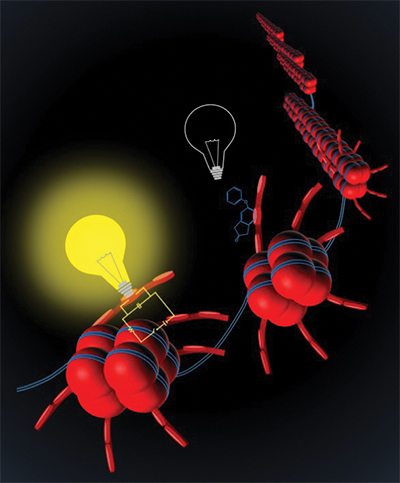JBC: In reading histone modifications, an oncoprotein is modified in return
Turning genes on and off is an intricate process involving communication among many different types of proteins that interact with DNA. These communications can go awry, resulting in conditions such as cancer.
 The lightbulb symbolizes TRIM24, a “histone reader” protein, which binds chromatin. Chromatin association triggers signaling to TRIM24, marked or “illuminated” by a post-translational modification called SUMOylation.Courtesy of Srikanth Appikonda
The lightbulb symbolizes TRIM24, a “histone reader” protein, which binds chromatin. Chromatin association triggers signaling to TRIM24, marked or “illuminated” by a post-translational modification called SUMOylation.Courtesy of Srikanth Appikonda
Researchers at the have uncovered an unusual form of crosstalk between proteins that affect gene expression, suggesting new ways of inhibiting metastasis in cancer. were published in the Journal of Biological Chemistry.
Tripartite motif-containing 24, or TRIM24, is an oncoprotein, meaning it is found in higher abundance in many types of cancer cells than in healthy cells. at MD Anderson studies this protein. Previous research has shown that TRIM24 is, among other things, an epigenetic reader. This means that it detects certain chemical modifications of histones — proteins around which DNA is coiled — and induces other proteins to change their behavior in response, resulting in a different pattern of genes being turned on than if the histone had not been modified.
In the new study, , a former postdoctoral fellow in Barton’s lab, found something unusual. Not only did TRIM24 “read” histone modifications, but the act of reading resulted in TRIM24 itself being modified with a small protein tag called a small ubiquitinlike modifier, or SUMO. In other words, reading the message of the histone made the reader carry its own chemical message.
“This is the first time that we know of that the (histone) itself is imposing a code on the modifiers or readers,” Barton said.
What does the addition of SUMO to TRIM24 accomplish? Appikonda, graduate student Kaushik Thakkar and the other team members performed experiments to see how the genes that TRIM24 turned on and off in cancer cells differed when TRIM24 didn’t have SUMO attached.
They found that the SUMO-modified TRIM24 seemed to be regulating genes involved in adhesion between cells. Cell adhesion determines whether cancer cells stay in one spot or can travel and metastasize through the body.
“That’s really where these cell-adhesion molecules are coming into play: metastasis and migration of cancer cells,” Barton said.
Multiple proteins are involved in adhesion, and TRIM24 turned some off and some on. Therefore, it’s not yet clear what net effect TRIM24 has on metastasis in cancer patients. But understanding that TRIM24 is involved in this process gives researchers a place to look to learn how to stop it.
In the meantime, the SUMO modification also can be used as a possible marker in studies of other types of potential new drugs. Cancer researchers often are interested in disrupting TRIM24’s interaction with histones in order to prevent aberrant gene expression. By tracking whether TRIM24 has SUMO attached, researchers can test whether a potential drug has blocked the interaction successfully.
“The exciting thing about learning more about modifications of TRIM24, such as SUMO, is to be able to develop antibodies or other means to detect its presence,” Barton said. “(This) may be a better predictor of cancers in early stages or could be linked to potential for metastasis.”
Enjoy reading ASBMB Today?
Become a member to receive the print edition four times a year and the digital edition monthly.
Learn moreGet the latest from ASBMB Today
Enter your email address, and we’ll send you a weekly email with recent articles, interviews and more.
Latest in Science
Science highlights or most popular articles

ApoA1 reduce atherosclerotic plaques via cell death pathway
Researchers show that ApoA1, a key HDL protein, helps reduce plaque and necrotic core formation in atherosclerosis by modulating Bim-driven macrophage death. The findings reveal new insights into how ApoA1 protects against heart disease.

Omega-3 lowers inflammation, blood pressure in obese adults
A randomized study shows omega-3 supplements reduce proinflammatory chemokines and lower blood pressure in obese adults, furthering the understanding of how to modulate cardiovascular disease risk.

AI unlocks the hidden grammar of gene regulation
Using fruit flies and artificial intelligence, Julia Zeitlinger’s lab is decoding genome patterns — revealing how transcription factors and nucleosomes control gene expression, pushing biology toward faster, more precise discoveries.

Zebrafish model links low omega-3s to eye abnormalities
Researchers at the University of Colorado Anschutz developed a zebrafish model to show that low maternal docosahexaenoic acid can disrupt embryo eye development and immune gene expression, offering a tool to study nutrition in neurodevelopment.

Top reviewers at ASBMB journals
Editors recognize the heavy-lifters and rising stars during Peer Review Week.

Teaching AI to listen
A computational medicine graduate student reflects on building natural language processing tools that extract meaning from messy clinical notes — transforming how we identify genetic risk while redefining what it means to listen in science.

.jpg?lang=en-US&width=300&height=300&ext=.jpg)